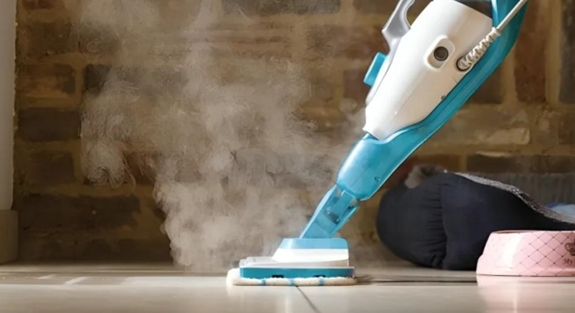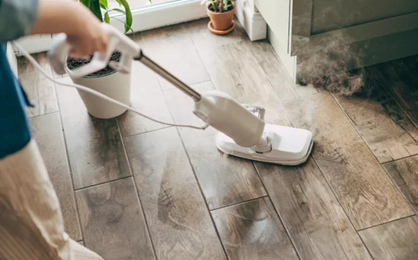Steam mops have revolutionized the way we clean our floors, offering a quick and efficient method to keep surfaces sparkling clean. However, not all floors are compatible with this cleaning tool. Understanding what floors can you use a steam mop on is essential to ensure the longevity of your flooring and the effectiveness of your cleaning efforts. This comprehensive guide will explore the science behind steam cleaning, identify which floors are safe for steam mops, discuss surfaces to avoid, and provide step-by-step instructions for optimal use.

How a Steam Mop Works and Why It’s Effective
The Science Behind Steam Cleaning
Steam cleaning utilizes high-temperature steam to break down dirt and grime on various surfaces. When water is heated to boiling point in the steam mop’s reservoir, it creates steam which is then expelled through a cleaning pad at the mop’s base. This steam loosens the grip of dirt and kills a significant number of pathogens upon contact. Because steam molecules are smaller, they can penetrate cracks and crevices that traditional mops can’t reach.
How Steam Mops Sanitize Surfaces
The high temperature of steam is effective in killing bacteria, viruses, and other microorganisms, making steam mopping not only a tool for cleanliness but also for sanitization. This is particularly beneficial for households with children or pets where hygiene is a top priority. The process is chemical-free, relying purely on water, which makes it safe and eco-friendly.
Benefits of Using a Steam Mop for Floor Cleaning
Time-Saving Benefits
Steam mops are designed to simplify the floor cleaning process. Traditional mopping requires multiple steps: sweeping, mopping, and then possibly drying the floor. Steam mopping combines several of these steps by loosening dirt and lifting it in one motion. This efficiency makes it an excellent choice for people with busy schedules.
Eco-Friendly Aspects of Steam Mopping
Using steam to clean floors eliminates the need for harsh chemicals. This not only reduces the chemical residue left behind on floors but also minimizes the environmental impact associated with producing and disposing of chemical cleaners. Steam mopping is thus a greener and safer option for your home and planet.
What Floors Can You Use a Steam Mop On?
Steam Mop on Hardwood Floors
You can use a steam mop on sealed hardwood floors, as the steam dries quickly, minimizing the risk of water damage. However, it’s important to be cautious with the steam settings. Use lower steam levels and avoid prolonged exposure to prevent any potential damage to the wood, ensuring the longevity and appearance of your floors.
Steam Mop on Tile Floors
Tile floors, including ceramic and porcelain, are highly durable and can easily handle the heat and moisture from a steam mop. Steam cleaning is particularly beneficial for grout lines, as the steam penetrates deep into the spaces, effectively removing hidden dirt and bacteria. This results in a more thorough clean, leaving your tile floors spotless and sanitized.
Steam Mop on Laminate Floors
Laminate floors can be safely cleaned with a steam mop, but only if they are properly sealed. To avoid potential damage, it’s essential to use the lowest steam setting and limit the exposure to moisture. This helps prevent water from seeping into the seams and causing warping or other issues. Always proceed with caution for optimal results.
Floors You Should Avoid Using a Steam Mop On
Steam Mop and Carpeted Floors
Steam mops are not recommended for carpeted floors due to the risk of prolonged moisture, which can lead to mold and mildew buildup underneath the carpet. The heat and steam can also damage the carpet fibers, reducing their lifespan. Carpets require specialized cleaners designed for textile surfaces to ensure proper care and avoid any damage caused by excessive moisture.
Steam Mop on Vinyl Floors
Vinyl floors can be adversely affected by the high heat and moisture produced by steam mops, especially if the vinyl is of low quality or poorly installed. The combination of heat and steam can weaken the adhesive used to secure the vinyl, causing the tiles or planks to shift, warp, or even peel, leading to potential long-term damage.
Why Steam Mops Can Damage Some Floors
Moisture is a common enemy of certain flooring types, especially unsealed wood, laminate, or any floor with cracks. Steam can easily penetrate these vulnerable areas, causing warping, peeling, or other forms of irreversible damage. To protect your floors, it’s essential to assess your floor type before using a steam mop. Always ensure your floor is steam mop-compatible to avoid costly repairs.

Step-by-Step Guide on Using a Steam Mop on Different Floors
Preparing Your Floor for Steam Cleaning
Start by thoroughly sweeping or vacuuming to remove loose dirt and debris. Since steam mops do not capture solid particles, prepping your floor is essential to prevent dirt from being smeared around. A clean surface ensures the steam mop can effectively clean and sanitize your floors, leaving them spotless without pushing dirt around or causing streaks. This step not only improves the mop’s efficiency but also helps avoid the buildup of grime on your floors.
Proper Technique for Using a Steam Mop
Fill the steam mop’s reservoir with distilled water to prevent mineral buildup and ensure long-term efficiency. Select the appropriate steam setting based on your floor type and ensure the cleaning pad is securely attached. Glide the mop slowly over the floor, allowing the steam to effectively lift dirt and stains. Be mindful not to leave the steam mop in one spot for too long, as prolonged heat exposure can damage the flooring.
Conclusion
Steam mops can be a game-changer in your cleaning arsenal if used correctly and on suitable floors. By understanding what floors can you use a steam mop on and the proper techniques to use, you can maintain a clean, hygienic environment. This guide has equipped you with the knowledge to make informed decisions about your floor care routines. By ensuring that you use the steam mop on compatible surfaces, you'll enhance its effectiveness and protect your floors from damage.
FAQ
Can you use a steam mop on hardwood floors?
Yes, but only on sealed hardwood floors. Unsealed wood can absorb moisture and warp, so it’s crucial to ensure your floor is properly sealed.
Is a steam mop safe for tile floors?
Absolutely. Tile floors are durable and can handle the high temperatures of steam, making them an excellent candidate for steam mopping.
How often should I use a steam mop on my floors?
For most floor types, using a steam mop once a week is sufficient. High-traffic areas may require more frequent cleaning, while less used spaces may need it less often.